The Intel Core i3-7350K (60W) Review: Almost a Core i7-2600K
by Ian Cutress on February 3, 2017 8:00 AM ESTLegacy and Synthetic Tests
At AnandTech, I’ve taken somewhat of a dim view to pure synthetic tests, as they fail to be relatable. Nonetheless, our benchmark database spans to a time when that is all we had! We take a few of these tests for a pin with the latest hardware.
Cinebench R10
The R10 version of Cinebench is one of our oldest benchmarks, with data going back more than a few generations. The benchmark is similar to that of the newest R15 version, albeit with a simpler render target and a different strategy for multithreading.
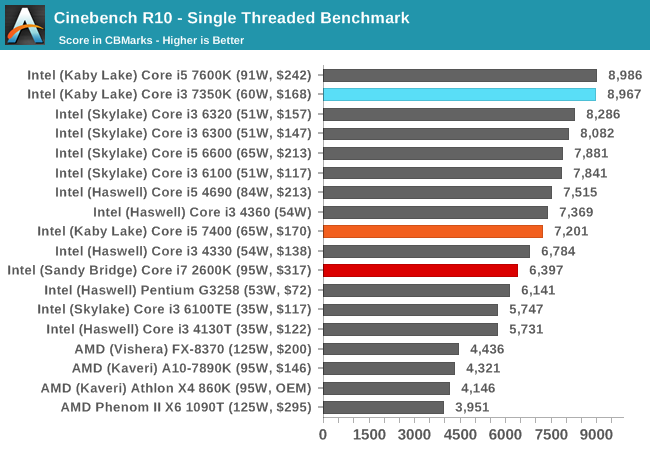
With high frequency in tow, the Core i3-7350K makes its mark.
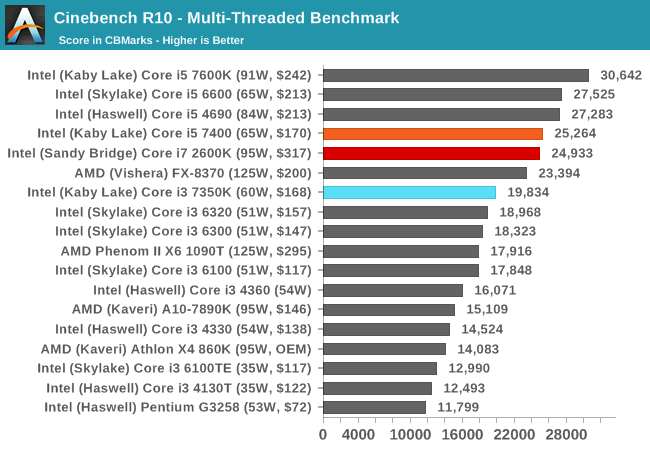
When more threads come to play, the Core i5-7400 and Core i7-2600K battle it out in terms of four cores and IPC vs hyperthreading. The Core i3-7350K sits around ~25% behind.
Cinebench R11.5
CB11.5 has been popular for many years as a performance test, using easy to read and compare numbers that aren’t in the 1000s. We run the benchmark in an automated fashion three times in single-thread and multi-thread mode and take the average of the results.
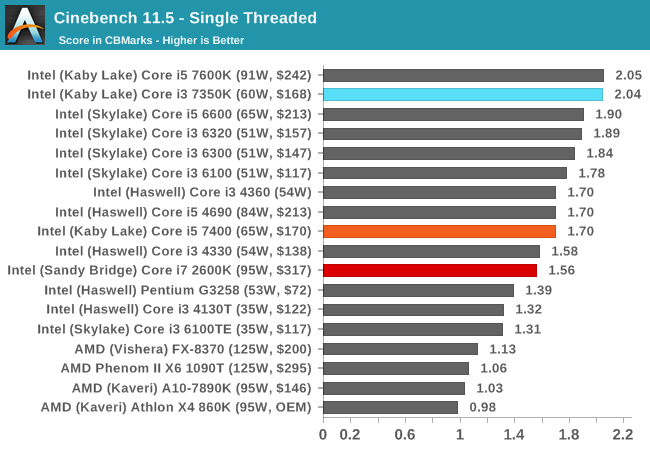
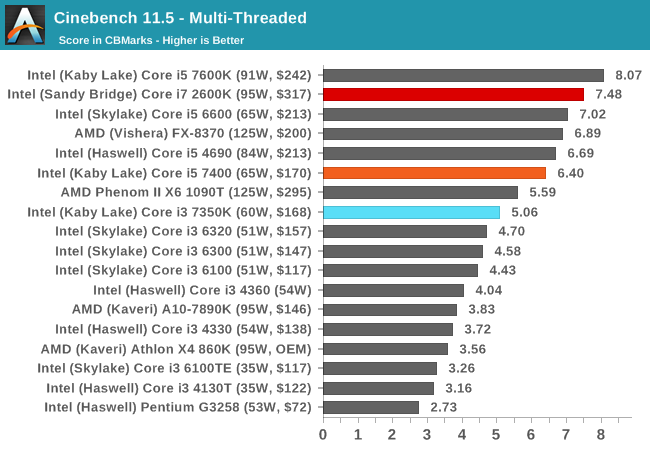
Similar to CB10, the single thread results show that a 4.2 GHz Kaby Lake is nothing to be sniffed at. In the multithreaded test, CB11.5 is more able to leverage the hyperthreads, showing that a Core i7-2600K will run rings around the low end Kaby i5, but is bested by the higher frequency Kaby i5-K. The Core i3 still has that dual core deficit.
7-zip
As an open source compression/decompression tool, 7-zip is easy to test and features a built-in benchmark to measure performance. As a utility, similar to WinRAR, high thread counts, frequency and UPC typically win the day here.
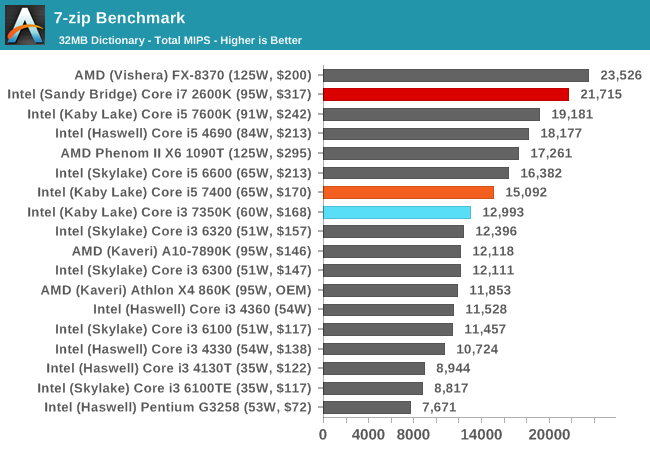
The difference between the i3-7350K and the i5-7400 shows that 7-zip prefers cores over threads, but the Core i7-2600K results show it can use both to good effect, even on older microarchitectures, scoring almost double the i3-7350K.
POV-Ray
Ray-tracing is a typical multithreaded test, with each ray being a potential thread in its own right ensuring that a workload can scale in complexity easily. This lends itself to cores, frequency and IPC: the more, the better.

POV-Ray is a benchmark that is usually touted as liking high IPC, high frequency and more threads. The i7-2600K, despite having double the resources of the Core i3-7350K, is only 30% ahead.
AES via TrueCrypt
Despite TrueCrypt no longer being maintained, the final version incorporates a good test to measure different encryption methodologies as well as encryption combinations. When TrueCrypt was in full swing, the introduction of AES accelerated hardware dialed the performance up a notch, however most of the processors (save the Pentiums/Celerons) now support this and get good speed. The built-in TrueCrypt test does a mass encryption on in-memory data, giving results in GB/s.
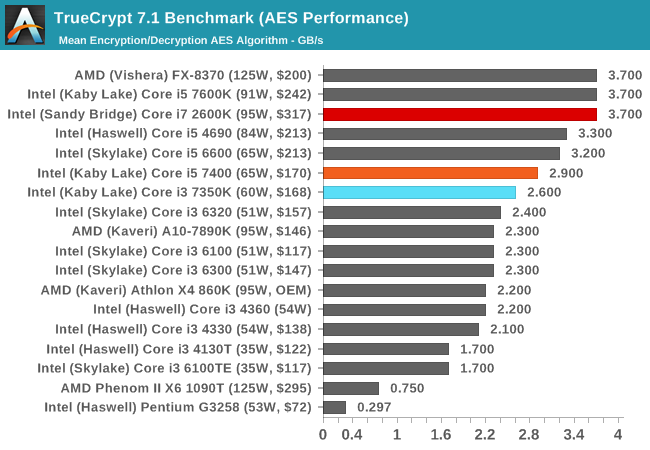










186 Comments
View All Comments
BillBear - Friday, February 3, 2017 - link
For consumers who intend to purchase a discrete GPU card, it's interesting to see it confirmed that Intel could include four additional CPU cores in instead of the unnecessary (for you) integrated GPU within pretty much the exact same die size.It wouldn't cost them more to manufacture than an i7. They just want to be able to charge more money by forcing you into a different price range of product if you need many cores.
For instance: Intel’s new 10-core Core i7 Extreme Edition costs a whopping $1,723
http://www.geek.com/tech/intels-new-10-core-core-i...
fanofanand - Friday, February 3, 2017 - link
I'm not sure I agree with your assessment. Intel has a vested interest in pushing people like you into the HEDT platform which is far more profitable. If you have a powerful dGPU then you are not "mainstream" by Intel's thinking. Based on the number of computers that have no dGPU maybe they are right.BillBear - Friday, February 3, 2017 - link
You're just defending price gouging now.fanofanand - Sunday, February 5, 2017 - link
I am not defending anything, I am neither an Intel shareowner nor have they seen a penny of mine in a decade. I am saying that what they are doing makes business sense even if it doesn't suit you as well as you'd like.BillBear - Sunday, February 5, 2017 - link
For someone who frequently responds to other people's posts with silly BS like "This post brought to you by CompanyName" why are you suddenly defending price gouging on Intel's part?Price gouging makes business sense for any company. Tacking on an additional thousand dollars per part? Not really defensible.
block2 - Friday, February 3, 2017 - link
The CPU I want is one that costs me the least electricity for the 95% of the time when I'm on Facebook and surfing, yet supports Photoshop well. I bought a gold rated seasonic PSU a couple years ago and my overall power usage is very low (40w?). Really, a low end i3 ought to suffice for me. I'm still using a 2.8ghz AMD phenom II with the CPU throttling enabled (800mhz).Scipio Africanus - Friday, February 3, 2017 - link
Have you considered one of the Intel T suffix cores? They don't get a lot of coverage but give you the newest architecture with a very low TDP. The current Kaby Lake T cores are 35w TDP.The newest review i could find was for Haswell T cores:
http://www.anandtech.com/show/8774/intel-haswell-l...
Scipio Africanus - Friday, February 3, 2017 - link
It takes Intel 6 years to post 25% increase in single threaded performance? Yeesh. Competiton (read: Ryzen) can't come fast enough. My Sandy Bridge Dell Precision is staying put for a bit more.StrangerGuy - Friday, February 3, 2017 - link
And AMD did what exactly during the same 6 years? Sheesh.silverblue - Saturday, February 4, 2017 - link
Well, they've transformed a power-hungry server architecture into something that the majority of users could use in a mobile device without complaining about power or performance. I'm also pretty sure that if they had commissioned Zen even before Bulldozer's release, we still wouldn't have seen anything until recently. I'm not going to defend them for Bulldozer, but it was either trash it and work on a replacement with no money coming in or at least try to fix its problems with power, L1 and decoder, and redesign the FPU. A 25%+ IPC boost from Bulldozer to Excavator, despite the loss of L3, would have been much better received had Bulldozer been better to begin with. That's what AMD have been doing.